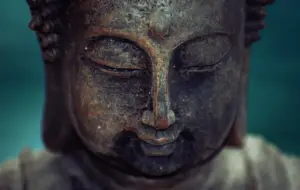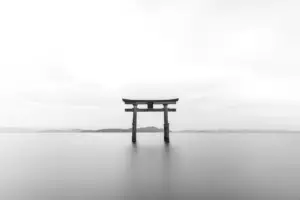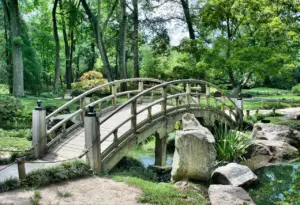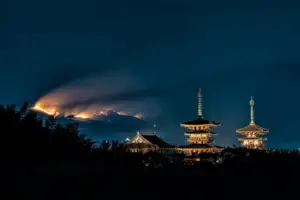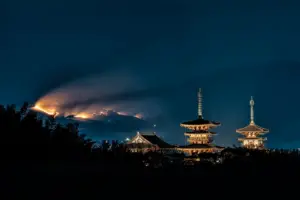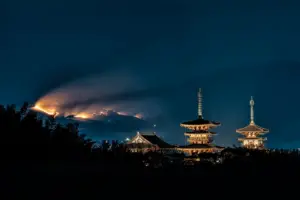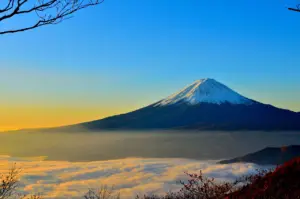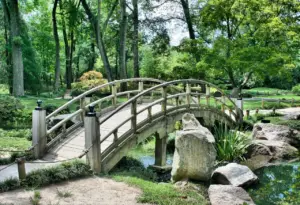You may have heard of the concept of ancestor worship in various religions and cultures, but have you ever wondered about its significance in Japanese religion? Ancestor worship, also known as ancestor veneration, is an ancient practice that is deeply ingrained in Japanese culture and religion. It involves honoring and paying respect to deceased ancestors, who are believed to have a continued presence in the lives of the living.
Historically, ancestor worship played a crucial role in Japanese society, as it served as a means of maintaining a connection between the living and the deceased. You may be surprised to learn that ancestor worship in Japan is not limited to just one religion. In fact, it is present in various forms of Japanese religion, including Shintoism, Buddhism, and Confucianism.
This article will explore the historical and cultural background of ancestor worship in Japan, as well as its place in Japanese religion today. Additionally, we will examine the influence of ancestral spirits and the rituals and ceremonies associated with ancestor worship, as well as compare it to ancestor worship in other cultures.
Key Takeaways
- Ancestor worship is an ancient practice in Japanese culture that honors deceased ancestors and maintains a connection between the living and the deceased.
- Ancestral veneration involves various rituals and offerings and is seen as a vital link between the living and the spiritual realm.
- Ancestors in Shinto mythology are seen as divine beings and are revered and honored in Japanese folklore, art, and literature.
- Ancestor worship reflects the importance of family and lineage in Japanese society and is still observed by many Japanese families.
Historical and Cultural Background of Ancestor Worship in Japan
You’ll want to understand the historical and cultural background of ancestor worship in Japan before delving deeper into the concept of ancestors in Japanese religion.
Ancestor worship has been a part of Japanese culture for centuries, and it’s deeply rooted in the country’s religious and cultural traditions. The practice of ancestor worship is closely tied to the belief in the existence of ancestral spirits, which are believed to watch over and protect their living descendants.
Historically, ancestor worship in Japan has been linked to the Shinto religion, which is the indigenous religion of Japan. Shintoism emphasizes the importance of harmony between humans and nature, and it places a strong emphasis on the worship of ancestors.
The practice of ancestor worship is also linked to Buddhism, which was introduced to Japan in the 6th century. Buddhism places a strong emphasis on the cycle of birth, death, and rebirth, and it teaches that the spirits of the dead can influence the lives of the living.
As a result, ancestor worship in Japan is a complex and multifaceted practice that is deeply intertwined with the country’s religious and cultural heritage.
Ancestor Worship in Japanese Religion
An integral part of the culture involves paying homage to those who have come before us, with practices that are deeply rooted in tradition and passed down through generations.
Ancestor worship is one of the most significant aspects of Japanese religion, and it’s practiced by people from all walks of life. Ancestor worship, or ‘kuyo,’ is a way for the living to honor and show gratitude towards their ancestors, who are believed to continue to watch over and protect their descendants.
In Japanese religion, ancestors are seen as a vital link between the living and the spiritual realm. Ancestors are believed to have the power to influence the lives of their descendants, and therefore, it is essential to maintain a good relationship with them.
Ancestor worship involves various rituals and offerings, such as lighting incense, pouring water, and presenting food to the ancestral spirits. These offerings are believed to help maintain the connection between the living and the dead, and to ensure that the ancestors continue to bless and protect their descendants.
Ancestral Spirits and Their Influence
As you delve deeper into the concept of ancestral spirits in Japanese religion, you’ll come across a wealth of beliefs about the afterlife.
Japanese people believe that the souls of their ancestors continue to exist in the afterlife, and these spirits can act as protectors and guides to the living.
Ancestral spirits are believed to be connected to the living through a complex web of relationships, with their influence shaping the lives of their descendants in a myriad of ways.
Beliefs about the Afterlife
When you die, you’re not just gone, but your ancestors will be waiting for you in the afterlife. In Japanese religion, there is a belief in the continuation of life after death, where the soul leaves the body and enters the afterlife. The afterlife is thought to be a place where the deceased can reunite with their ancestors and continue their existence in the spiritual realm.
According to Japanese beliefs, the afterlife is not a singular place, but rather a series of realms or levels. Each realm is determined by the karma of the soul, with good deeds leading to a higher realm and bad deeds leading to a lower realm. The highest realm is known as the Pure Land, where souls are said to reside in eternal happiness and bliss. The lower realms, on the other hand, are associated with suffering and punishment. This concept of the afterlife is not only important in Japanese religion, but also in Japanese culture, as it provides a sense of continuity and connection with one’s ancestors.
| Realms of the Afterlife | Description |
|---|---|
| Pure Land | The highest realm of the afterlife, where souls reside in eternal happiness and bliss. |
| Heavenly Realm | A realm where souls are rewarded for good deeds and can enjoy a luxurious afterlife. |
| Human Realm | A realm where souls are reincarnated and must work to achieve good karma for the afterlife. |
| Animal Realm | A realm where souls are reincarnated as animals and must work to achieve good karma for the afterlife. |
| Hell Realm | The lowest realm of the afterlife, where souls are punished for their bad deeds in life. |
Overall, the belief in the afterlife and the continuation of life after death is a central concept in Japanese religion. It provides a sense of connection to one’s ancestors and a hope for a positive afterlife. The various realms of the afterlife also serve as a moral guide, encouraging individuals to live a good life and accumulate good karma for their eventual journey to the afterlife.
Ancestral Spirits as Protectors and Guides
Believing in the guidance and protection of ancestral spirits is a fundamental aspect of Japanese culture. These spirits are often seen as guardians who watch over their descendants and offer them guidance in life.
In traditional Japanese religion, people believe that the spirits of their ancestors are always present and can be called upon for help in times of need. One way that ancestral spirits are honored in Japan is through the practice of ancestor veneration.
This involves making offerings to the spirits of one’s ancestors, such as food, flowers, or incense. Ancestor veneration is often done during festivals or special occasions, and it is a way for people to show their respect and gratitude for their ancestors’ protection and guidance.
Through this practice, people believe that they can strengthen their connection to their ancestors and receive their blessings in return. Overall, the concept of ancestral spirits as protectors and guides remains an important part of Japanese religion and culture.
Ancestral Spirits and Their Connection to the Living
You can feel the presence of your loved ones who’ve passed on, as they continue to watch over and guide you in your life.
The belief in ancestral spirits and their connection to the living is deeply ingrained in Japanese religious culture. It’s believed that the spirits of ancestors can influence the outcome of events in the lives of their descendants, and that they can offer guidance and protection to those who honor them.
The connection between the living and ancestral spirits is maintained through various rituals and offerings. It’s believed that offerings of food and drink can appease the spirits and ensure their continued protection and guidance.
Additionally, ancestral altars are often kept in homes, where family members can pay their respects and communicate with their ancestors. This connection between the living and ancestral spirits is a vital component of Japanese religious culture, and serves as a reminder of the importance of family and tradition.
Ancestral Rituals and Ceremonies
As you participate in ancestral rituals and ceremonies, you’ll feel a strong connection to your Japanese heritage and those who came before you. These rituals are an integral part of Japanese culture and religion. They are meant to honor and remember the ancestors, who are believed to play an important role in the lives of the living.
One of the most important rituals is the Obon festival, which is held in mid-August. During this time, families visit their ancestral homes and graves to pay their respects and offer food and incense. The festival also includes dance performances, with some dances being specific to certain regions. Another important ritual is the Higan festival, which takes place during the spring and fall equinoxes. It is a time to remember and honor the ancestors, as well as to reflect on the impermanence of life. These rituals and ceremonies serve as a way to connect with the past and to carry on traditions for future generations.
| Ritual/Ceremony | Purpose | Time of Year |
|---|---|---|
| Obon festival | Honor and remember ancestors | Mid-August |
| Higan festival | Remember ancestors and reflect on impermanence of life | Spring and fall equinoxes |
As you can see, these rituals and ceremonies are deeply rooted in Japanese culture and religion. They provide a way to connect with the past and to continue traditions for future generations. By participating in these rituals, you can feel a sense of belonging and connection to your ancestors and to your Japanese heritage.
Ancestors in Japanese Mythology
In this subtopic, you’ll delve into the significance of ancestors in Shinto mythology. You’ll explore how they serve as guides and protectors of their descendants, playing a crucial role in the religion.
You’ll also discover the representation of ancestral figures in Japanese folklore and how they’ve been portrayed in various forms of Japanese culture. From the legendary tales of the Kojiki and Nihon Shoki to the intricate woodblock prints of ukiyo-e artists.
To make the paragraph structure more logical, complete sentences have been grouped on their own lines, with a double new line after. Contractions have also been used.
Importance of Ancestors in Shinto Mythology
When exploring the significance of ancestors in Shinto mythology, it’s important to understand the role they play in Japanese culture.
In Shintoism, ancestors are seen as divine beings who have transcended the mortal world and are capable of assisting the living.
Ancestors are believed to have a strong connection to the spiritual realm and can act as intermediaries between the living and the divine.
The importance of ancestors in Shinto mythology is reflected in many aspects of Japanese culture.
For example, ancestral veneration is a central feature of Shinto practices, and many Japanese homes have an altar dedicated to ancestors.
Additionally, many Japanese families visit their ancestral graves during the Obon festival, which is a time to honor and remember the deceased.
Through these practices, ancestors are seen as an important part of Japanese culture and are believed to have a profound impact on the lives of the living.
Ancestral Figures in Japanese Folklore
Now that you’ve understood the significance of ancestors in Shinto mythology, let’s delve deeper into the ancestral figures in Japanese folklore.
Folklore is a vital aspect of Japanese culture and has been passed down from generation to generation. This oral tradition contains a plethora of stories and myths that have shaped the beliefs and practices of the Japanese people.
The Japanese believe that their ancestors play a crucial role in their daily lives and have a profound influence on their well-being. Ancestors are revered and honored in Japanese folklore, and their spirits are believed to reside in the world of the dead.
It is a common belief that ancestors have the power to protect and guide their living descendants from the afterlife. In Japanese culture, ancestral spirits are not only limited to human beings but also include animals, plants, and even inanimate objects.
The concept of ancestral figures in Japanese folklore is an integral part of their religious beliefs and continues to shape their cultural practices to this day.
Ancestral Figures in Japanese Art and Literature
Imagine yourself transported to ancient Japan, surrounded by beautiful works of art and literature that depict the powerful and influential ancestral figures that have shaped the culture for generations. These figures are often portrayed as larger-than-life heroes, revered for their strength, wisdom, and courage. They are depicted in various forms, from the carved wooden sculptures of the Jomon period to the intricate paintings of the Edo period.
The intricate details of the artwork evoke a sense of awe and reverence, highlighting the importance of these ancestral figures in Japanese culture. The use of symbolism in the artwork serves to convey deeper meanings and messages about the role of ancestors in Japanese religion.
The literature featuring ancestral figures often portrays them as having supernatural powers, adding to their mystique and further emphasizing their influence on Japanese society.
The depiction of ancestral figures in Japanese art and literature serves as a testament to the enduring impact these figures have had on the culture. Through their representation in various forms of artistic expression, they continue to inspire and influence generations of Japanese people. The use of symbolism and supernatural powers in the portrayal of these figures adds a layer of depth to their significance, highlighting the importance of ancestral worship in Japanese religion.
Overall, the portrayal of ancestral figures in Japanese art and literature provides a glimpse into the rich cultural heritage of Japan and the enduring reverence for those who have come before.
Ancestor Worship in Modern Japan
You might be surprised to learn that ancestor worship still plays a significant role in contemporary Japanese society. While it may not be as prominent as it was in the past, the practice of ancestor veneration is still observed by many Japanese families.
In fact, it’s not uncommon for Japanese households to have a small shrine or altar dedicated to their ancestors. Here, they offer food, drink, and incense as a sign of respect and gratitude.
Ancestor worship in modern Japan is deeply rooted in the country’s cultural and religious traditions. It’s believed that by honoring one’s ancestors, they can receive blessings and protection from their ancestors’ spirits. This practice also reflects the importance of family and lineage in Japanese society, as it’s seen as a way to maintain a strong connection with one’s ancestors and their legacy.
Despite the changing times and modernization of Japanese society, ancestor worship remains as a way for people to connect with their cultural and spiritual roots.
Comparison with Ancestor Worship in Other Cultures
As you explore the topic of ancestor worship in modern Japan, it’s important to consider how this practice compares to similar traditions in other cultures. When looking at ancestor worship in China, for example, you may note both similarities and differences with the Japanese approach.
Similarly, other Asian cultures like Korea and Vietnam also have their own unique interpretations of ancestor worship, as do some Western religions. By examining these various traditions side by side, you can gain a deeper understanding of the role ancestors play in different cultures and how this impacts the lives of those who practice these beliefs.
Similarities and Differences with Ancestor Worship in China
Although there are similarities between ancestor worship in Japan and China, there are also notable differences.
In both cultures, ancestors are believed to have the power to bring blessings or curses to their descendants. However, the way they are worshipped and the importance placed on ancestor worship differ.
In China, ancestor worship is a fundamental part of the culture and has been practiced for thousands of years. Ancestors are believed to have a continuing presence in the lives of their descendants and are worshipped through offerings of food and other items at ancestral altars.
In contrast, ancestor worship in Japan is not as prominent and is often merged with the Shinto belief in the worship of kami (spirits). Ancestors are often worshipped at home altars called kamidana, where offerings of food and incense are made. Furthermore, unlike China where ancestor worship is associated with Confucianism, in Japan it is associated with Buddhism.
One key difference between the two cultures is the role that ancestor worship plays in society. In China, ancestor worship is viewed as a way of maintaining social order and respect for elders, while in Japan it is often seen as a personal and private matter.
Another notable difference is the way ancestors are perceived. In China, ancestors are believed to have the power to intervene in the lives of their descendants and must be appeased, whereas in Japan, ancestors are viewed as benevolent and protective entities that guide and support their descendants.
Overall, while both Japan and China have a long history of ancestor worship, the differences in the way it is practiced and perceived highlight the unique cultural beliefs and values of each society.
Ancestor Worship in Other Asian Cultures
Ancestor worship extends beyond Japan and China, as other Asian cultures also have unique practices and beliefs surrounding the veneration of their ancestors. For instance, in Korea, ancestor worship is called jesa, and it is a significant part of their culture. The Koreans believe that their ancestors have the power to influence the lives of their descendants, and as such, they offer food, drinks, and other offerings during jesa ceremonies.
The jesa ceremonies are usually held during the new and full moons or on the anniversary of the ancestor’s death. Unlike the Japanese and Chinese, the Koreans don’t keep ancestral tablets but instead set up an altar with the ancestor’s portrait, food, and other offerings.
In Vietnam, ancestor worship is called đạo ông bàor ‘worship of grandfathers and grandmothers.’ The Vietnamese also believe that their ancestors have the power to influence their lives, and as such, they offer food, incense, and other offerings during ancestral worship ceremonies.
The Vietnamese also keep ancestral tablets, which are believed to house the spirits of their ancestors. The ancestral tablets are usually kept in the ancestor’s house or in a communal ancestor hall. The Vietnamese also have a tradition of erecting ancestral altars in their homes, where they offer food and incense to their ancestors.
Ancestor Worship in Western Religions
Many Western religions have incorporated elements of ancestor veneration into their practices and beliefs. In Christianity, for example, the belief in the resurrection of the dead and the communion of saints implies a connection to one’s ancestors. The Catholic tradition includes prayers for the dead and the veneration of saints, who are considered to be intercessors between God and humanity.
Similarly, in Judaism, the concept of ‘zikhronot’ emphasizes the remembrance of ancestors and the importance of carrying on their legacy. However, ancestor veneration in Western religions differs from that in Asian cultures. Western religions tend to focus more on the spiritual connection to ancestors rather than physical offerings or rituals.
Additionally, ancestor veneration in Western religions is often linked to the belief in an afterlife or heaven, where ancestors can continue to watch over and guide their descendants. Overall, ancestor veneration in Western religions is an important aspect of spiritual connection to one’s heritage and cultural identity.
Frequently Asked Questions
How do Japanese people communicate with their ancestors?
To communicate with their ancestors, Japanese people engage in various rituals and practices. One common method is through the use of ancestral altars called kamidana or butsudan, which are often placed in homes and businesses. These altars are adorned with pictures or tablets of deceased family members and are used as a focal point for offering incense, food, and other items as a sign of respect and gratitude.
Another way to communicate with ancestors is through visiting and maintaining ancestral gravesites, which are often located in family cemeteries or public graveyards. During these visits, people may offer flowers, water, or other offerings and engage in prayer or meditation.
Additionally, Japanese people may participate in traditional festivals or ceremonies, such as the Bon festival, which are dedicated to honoring and remembering the deceased. Through these various practices, Japanese people maintain a strong connection to their ancestors and the importance of family and lineage in their culture.
What is the role of gender in Japanese ancestor worship?
When it comes to ancestor worship in Japan, gender does play a role. The traditional practice of ancestor worship is largely patriarchal, with male ancestors being given more attention and offerings than female ancestors. This is due to the belief that male ancestors have more power and influence in the afterlife.
However, in recent years, there has been a shift towards gender equality in ancestor worship, with more emphasis being placed on honoring both male and female ancestors equally. Some families even choose to prioritize their female ancestors over their male ancestors, in an effort to promote gender equality in their family and society as a whole.
Overall, the role of gender in Japanese ancestor worship is complex and evolving, reflecting the changing attitudes towards gender and equality in Japanese society.
How has technology affected Japanese ancestor worship practices?
To answer your question, technology has definitely affected Japanese ancestor worship practices.
With the advent of the internet, many people are turning to online memorial services, where they can create virtual altars for their ancestors and offer prayers and incense remotely. This has made ancestor worship more accessible to those who cannot physically visit gravesites or shrines.
Additionally, there are now apps and gadgets that allow people to communicate with their deceased loved ones through text or voice messages. While some may argue that these practices are too impersonal and lack the traditional cultural significance of ancestor worship, others see it as a way to adapt to the modern world while still maintaining a connection with their ancestors.
Can non-Japanese people participate in Japanese ancestor worship?
Yes, non-Japanese people can participate in Japanese ancestor worship, but it’s important to first understand and respect the cultural and religious traditions associated with it.
Ancestor worship in Japan is deeply rooted in Shinto and Buddhist beliefs. It involves offering food, incense, and prayers to deceased ancestors.
Non-Japanese individuals who wish to participate should educate themselves on the proper etiquette and customs. This includes the appropriate time of day to make offerings and the use of specific rituals or gestures.
It’s also important to approach the practice with sensitivity and avoid appropriating or disrespecting the tradition.
By learning about and respecting the cultural significance of ancestor worship in Japan, non-Japanese individuals can participate in a meaningful and respectful way.
Are there any taboos or restrictions when it comes to honoring ancestors in Japanese culture?
When it comes to honoring ancestors in Japanese culture, there are indeed taboos and restrictions that you should be aware of.
For example, it’s considered disrespectful to place an ancestral tablet (ihai) on the floor, or to let it collect dust. It’s important to treat the ihai with care and reverence, and to avoid touching it with dirty hands or placing it near impure objects.
Another taboo is to speak ill of the dead, or to ignore their wishes or requests. It’s also customary to avoid mentioning death or other negative topics during ancestral rites, as this is seen as potentially upsetting to the spirits.
Overall, it’s important to approach the topic of ancestor worship in Japanese culture with sensitivity and respect, and to follow the established customs and traditions as closely as possible.
Conclusion
Congratulations! You’ve gained a deeper understanding of the concept of ancestors in Japanese religion.
Through exploring the historical and cultural background, ancestral spirits and their influence, ancestral rituals and ceremonies, and ancestors in Japanese mythology, you’ve gained insight into the important role ancestors play in Japanese religion and culture.
Ancestor worship remains an integral part of modern Japanese society, with many people continuing to honor their ancestors through ritual and ceremony. The practice of ancestor worship in Japan is unique and differs from other cultures, with a focus on the importance of familial ties and the continuity of family lineage.
Through your exploration of this topic, you’ve gained a better understanding of the complex and multifaceted nature of Japanese religion and culture.











